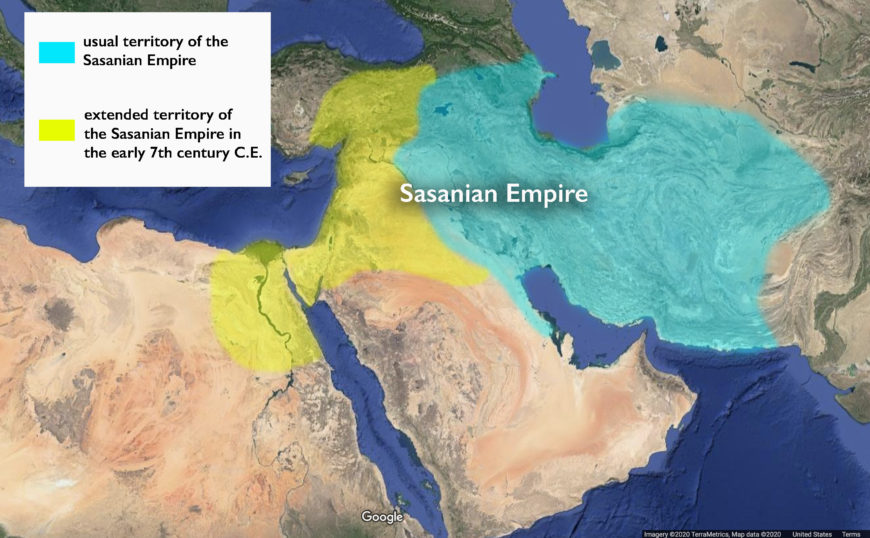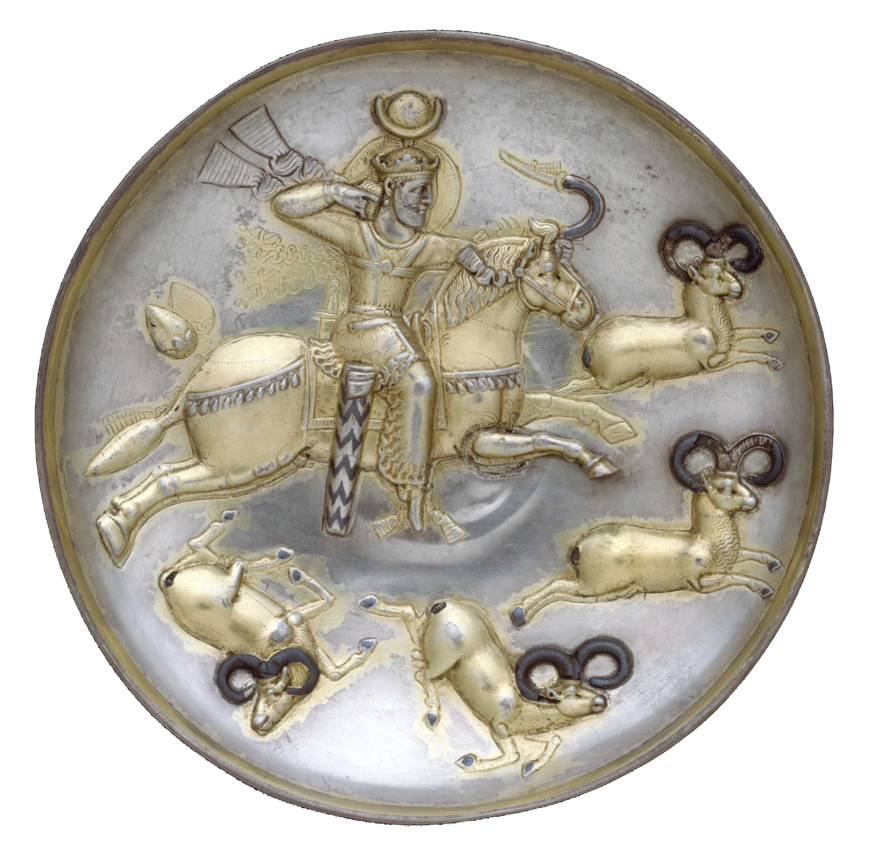
Plate with a king hunting rams, Sasanian Iran, 5th–6th century C.E., silver with mercury gilding and niello inlay; 21.9 cm diameter (The Metropolitan Museum of Art)
The Royal Hunter
A rider pulls back the taut string of a bow with his right hand and aims an arrow towards two fleeing mountain rams with his left. The chase is fast; the rams sprint forward with the rider’s horse galloping just behind their tails. The confident rider has already shot two mountain rams lying contorted underneath the horse’s hooves. This rider appears rather extraordinary. He does not wear practical sporting attire, but fluttering layers of clothes and ribbons, and a massive crown pulls the upper half of his curly hair into a bun resting in a crescent. A halo circling his head elevates him to a quasi-divine status. This gilded silver plate depicts an idealized portrait of a Sasanian Shahan Shah, or King of Kings, on a royal hunt.
Sasanian Art and Archaeology
A court artisan created this luxurious, handheld plate under the Sasanian Dynasty (224–651 C.E.). The Sasanians were the last pre-Islamic Iranian dynasty who ruled an expansive empire stretching across western and central Asia. The Sasanians called their empire Eranshahr, the Empire of the Iranians. Much of the material culture that survives is court art, that is, luxury objects and royal monuments created and used by the empire’s ruling and elite strata of society.
The owners of luxury items like the royal hunting plate, passed their possessions on through many hands, whether as heirlooms, gifts, or barter. Many Sasanian luxury goods traveled extensively across the Eurasian landmass, ultimately landing in locations that range from French church treasuries and Chinese burials to hoards sprinkled across present-day Russia. Monumental art and architecture remained in situ. Some cities and sites fell into disuse (like Bishapur), while others experienced later layers of development (like Takht-e Soleiman under the Mongol Ilkhanids). Medieval and premodern Islamic authors documented Sasanian sites as part of the region’s rich history. By the eighteenth century, European travelers also began to record Sasanian monuments alongside those of the earlier Arsacid (also called Parthian) and Achaemenid dynasties of Iran. This enthusiasm for rediscovering Iran’s past led to large-scale archaeological excavations in the twentieth century. Though most projects have focused on palatial sites, more recent campaigns have also eagerly turned towards the everyday lives of ordinary citizens of the empire.
This essay briefly introduces the Sasanian Empire through a handful of key monuments. It provides insight into how Sasanian rulers perceived their place in the world, and how they conveyed this understanding to both denizens within the empire and to those beyond its frontiers. It also illustrates how the Sasanians materialized their artistic values while simultaneously building bridges both with an Iranian past and with their contemporary neighbors of Rome, China, and Central Asia.
Google Maps Street View of Taq-e Kesra, Ctesiphon (present-day Al-Mada’in, Iraq)
Performing Kingship
A hallmark of royal Sasanian architecture is the ayvan (referred to as an iwan in the Arabic), a vaulted space closed on three sides, and open on the fourth. Sasanian-era architects designed palatial complexes around a central ayvan that the Sasanian Shahan Shah utilized for courtly events and spectacles. At the Sasanian capital of Ctesiphon, on the Tigris River near present-day Baghdad, Iraq, stands perhaps the most famous ayvan, known as the Taq-e Kesra, the Arch of Khosrow. The ayvan is still the largest vault of unreinforced brick in the world, raising 35 meters in height and stretching over 25 meters in width.
Early Islamic historians and poets recorded how the Sasanians adorned the walls with molded stuccos, mosaics, and wall paintings, and covered the floors with carpets and cushions. Several authors furthermore described how the king positioned his throne in the center of the ayvan and suspended his ostentatiously embellished crown from the ceiling to support its massive weight. When hosting events, the king seated the empire’s elites according to rank. He symbolically reserved the three seats nearest to him for the leaders of neighboring Rome, China, and the Steppe. Thus the ayvan became a stage for performing a world political cosmology with the Sasanian King positioned at the center. After the fall of the Sasanian Empire, the ayvan would remain a distinctive feature of Iranian and greater Persianate architecture, composing mosques (like the Great Mosque of Isfahan), madrasas (an Islamic school), and caravansaries (a premodern inn for travelers and their animals).
Monumental Image-Making
Alongside crafting extravagant spaces for politically charged performances, the Sasanian dynasty utilized the natural landscape to construct large rock reliefs that depicted divine investiture, triumph over foreign rulers, and royal family portraits. The Sasanian kings strategically selected locations on sacred waterways, roads that led in and out of the empire, as well as near other stone monuments built by bygone empires.
Google street view of Naqsh-e Rustam (present-day Fars Province, Iran)
The first Sasanian Shahan Shah, Ardashir I, commissioned one of his reliefs at the base of an escarpment known today as Naqsh-e Rustam, a site used as a royal necropolis by the earlier Achaemenid Dynasty. This relief illustrates the Zoroastrian god, Ohrmazd, who bestows Ardashir’s right to kingship.
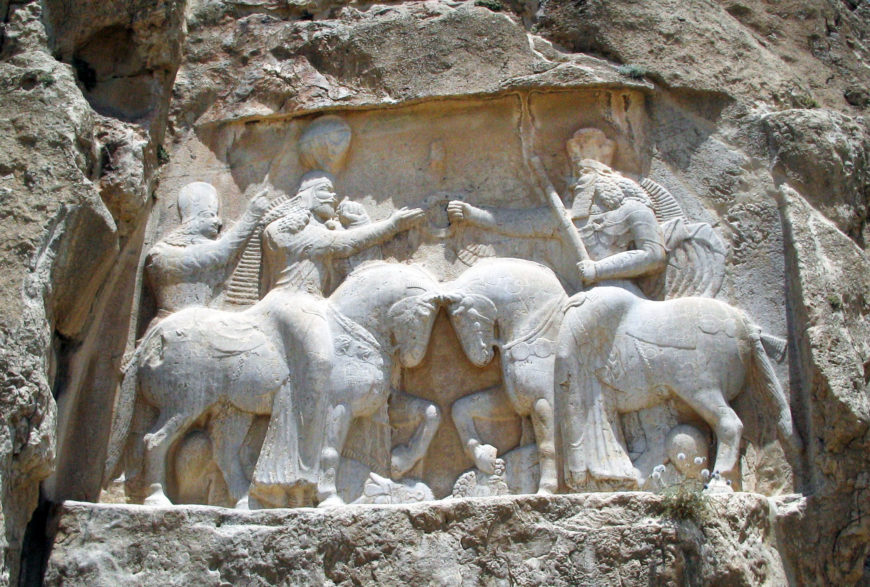
Divine Investiture of Ardashir I (r. 224-242 C.E.), Sasanian Iran, 3rd century C.E., rock relief, in situ at Naqsh-e Rustam (present-day Fars Province, Iran; photo: Fabienkhan, CC BY-SA 2.5)
The god represented in human form on the right is the highest god in the Zoroastrian pantheon, an ancient, indigenous Iranian religion. Ardashir, on the left, stretches out a hand to receive a divine ring from Ohrmazd. The king and god mirror one another: not only do they stand in an identical position and wear similar garments, but also they share a hierarchy of scale with the king’s crown that even rises above Ohrmazd. The relief furthermore illustrates Sasanian triumph over the earlier Arsacid Dynasty. The last Arsacid king lies trampled under the hooves of Ardashir’s horse. Under the hooves of Ohrmazd’s horse is Ahriman, an evil spirit and the primary opponent of Ohrmazd, according to Zoroastrian doctrines.
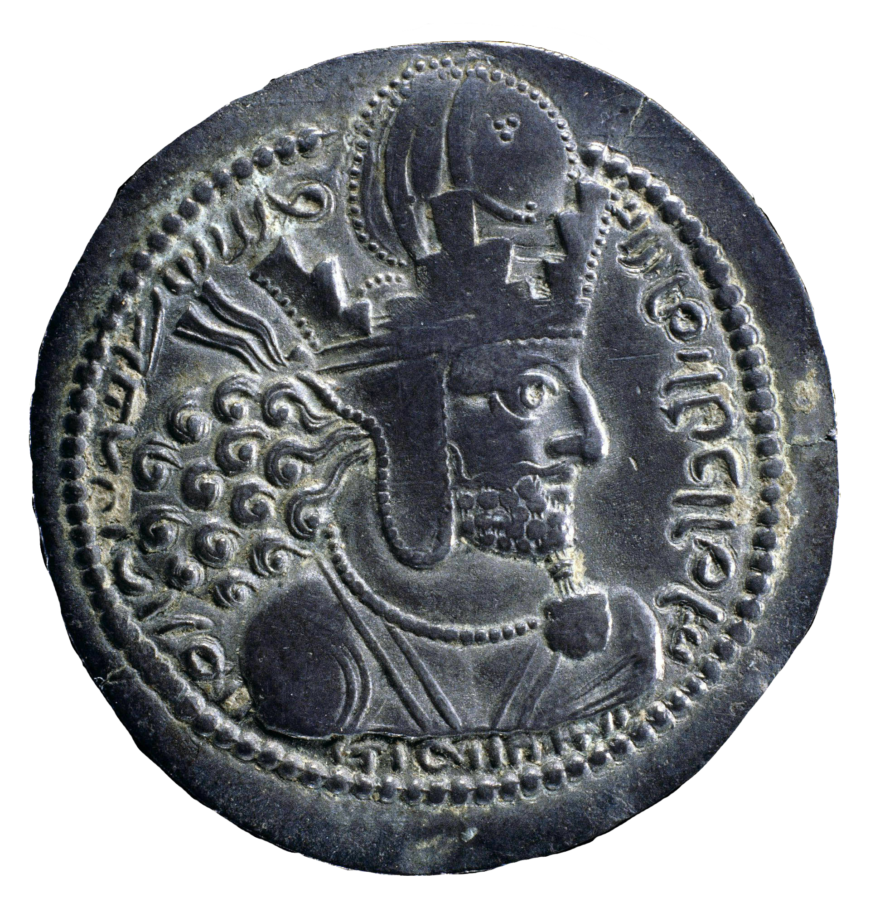
Drachm of Shapur I (r. 241–272 CE), Sasanian Iran, 3rd century C.E., silver, 26 mm diameter (© The Trustees of the British Museum)
Miniature Image-Making
In combination with site-specific monumental images, rulers fashioned imagery for coinage that they could circulate within the empire and beyond its frontier. Sasanian silver drachms (the main denomination of coinage under the Sasanians) typically featured a profile portrait of the ruler on the obverse (front of a coin). A Zoroastrian fire altar flanked by two attendants occupied the reverse (back of a coin). Rulers utilized coins to showcase their distinctive crowns. For example, Shapur I wears a crenelated crown lined with pearls and hair pulled up into a large bun on the top of his head. On the other hand, Boran wears a cap-like crown studded with jewels and topped with two wings and a crescent lifting the hair. Shapur I was the first to inscribe on coinage that he was not merely the King of Eran (Iran) but also Aneran (non-Iran). This message disseminated a cosmology that placed the Sasanian king at the center of the world.
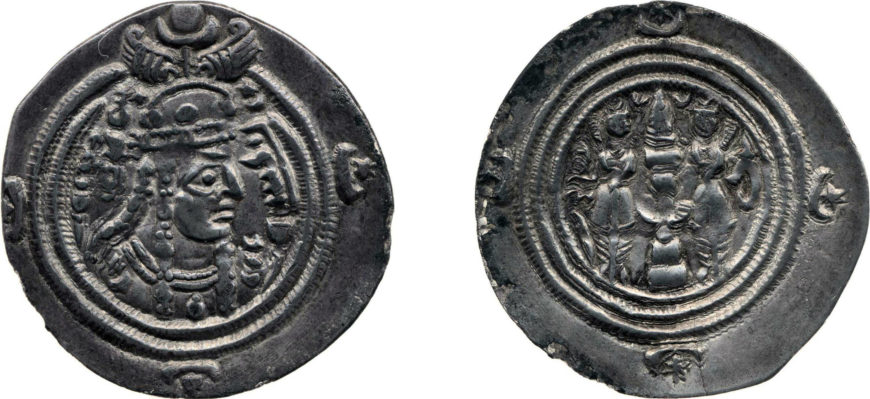
Drachm of Boran (ruled c. 630), Sasanian Iran, 7th century C.E., silver, 29 mm diameter (© The Trustees of the British Museum)
Boran is particularly notable in the history of Iran. She was a female head of state who took the same title, Shahan Shah, as her male counterparts. Despite taking reign in a period of chaos, she was a sharp leader who constructed roadways and facilitated peace with Byzantium after nearly 30 years of war under her father, Khosrow II.
Sasanian coins were not only produced and utilized across the empire but also valuable currency far beyond its frontiers. Archaeologists have unearthed Sasanian coins across Eurasia, from Chinese tombs to Scandinavian hoards. Early Islamic dynasties furthermore used Sasanian coin imagery as a prototype until eventually transitioning to wholly calligraphic imagery.
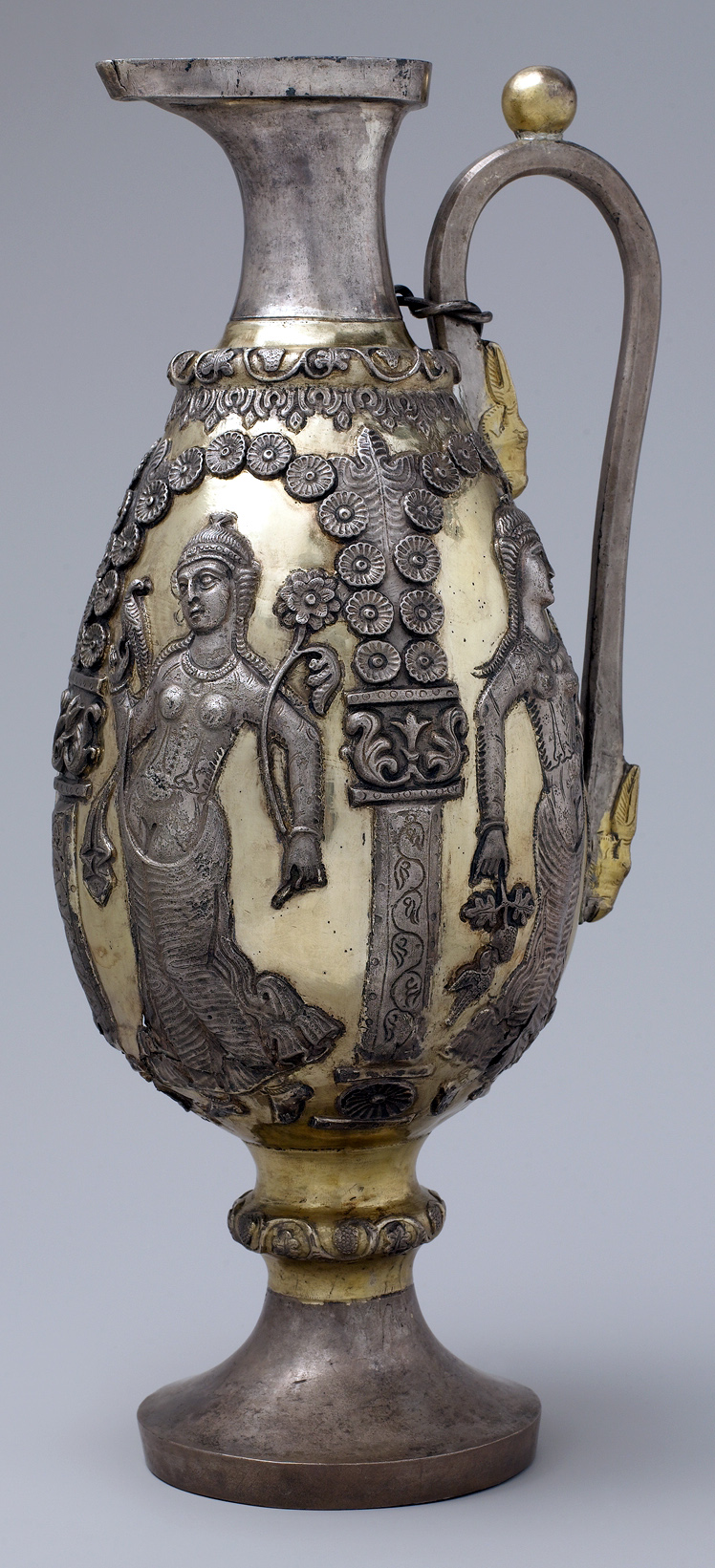
Wine decanter with women dancing, Sasanian Iran, 6th to 7th century C.E., silver with mercury gilding, 34 cm high (The Metropolitan Museum of Art)
Feasting and Fighting
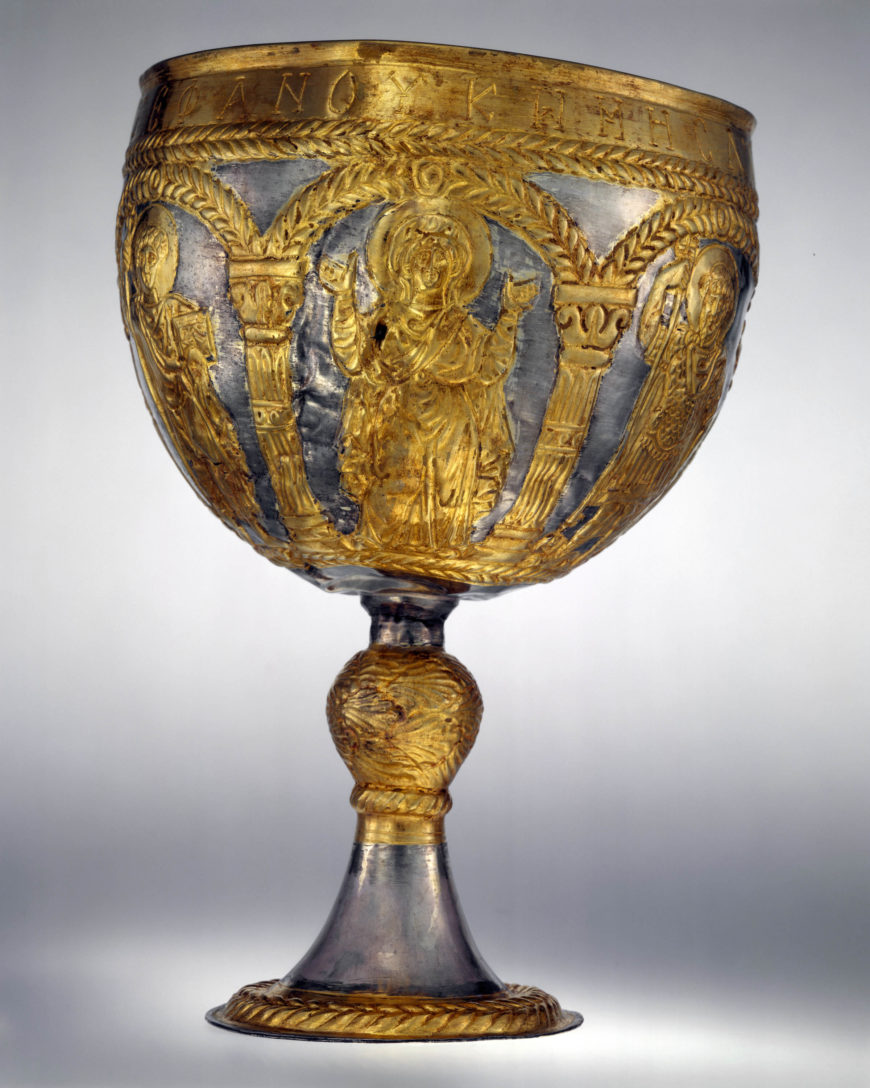
Chalice (The Attarouthi Treasure), Byzantine, silver and gilded silver, 500–650 C.E., The Metropolitan Museum of Art)
The Sasanians enjoyed dining and drinking together, a social event that is visible through ceramic, glass, and silver vessels. Elite circles handled silver cups, plates, and bowls on which artisans hammered and chased intricate designs. The imagery is often playful, representing animals, vegetation, and banqueting entertainment. One wine decanter depicts four women scantily draped in luxurious textiles under an arcade. Each dancer is unique, holding flowers, a bird, a mirror, and even a pitcher (also called an ewer) like that on which the artist created the image. The stylistic framing device of figures set beneath an arcade that rotates around the vessel is one shared with contemporary Byzantine silver—where it appears on sacred Christian liturgical vessels, for example on this Chalice from the Attarouthi Treasure.
Banquets featuring dancers, musicians, and acrobats were part of a court culture shared across early medieval Eurasia. This allowed foreign visitors, such as diplomats and merchants, to partake in other cultures’ festivities. Some silver vessels were created for festivities. However, others were less practical and served as courtly gifts, such as the hunting plate introduced at the beginning of this essay. In particular, hunting imagery added an extra dimension to the plate’s undeniable luxury and intrinsic value: imagery showcasing the king’s martial prowess was propagandistic but less overt than the rock reliefs of a king treading an opponent. This combination of spectacular celebrations and hunting feats, called bazm u razm in Persian, would occupy an essential place in the history and legends of the Sasanian Empire. The most famous epic, the Shahnama, or the Book of Kings, written by the poet Ferdowsi, would share tales of Sasanian kings for centuries to come.
A glimpse of the Sasanian Empire
These objects offer a glimpse into the visual construct of the Sasanian Empire. The Sasanians strategically fit themselves into a deep lineage of Iranian heritage while simultaneously building a dialogue with their neighbors. Furthermore, the Sasanian legacy would remain a vital foothold for many Persianate cultures to come.

